
Introduction
Facebook, Dropbox, Twitter - $75 billion yearly revenue, nearly 4 billion active users, and one lowest common denominator; a customer-centric MVP (Minimum Viable Product).
The truth is that at their launch and early stages, these companies lacked most of the features you can see today.
As a matter of fact, both Facebook and Twitter looked rather simple.
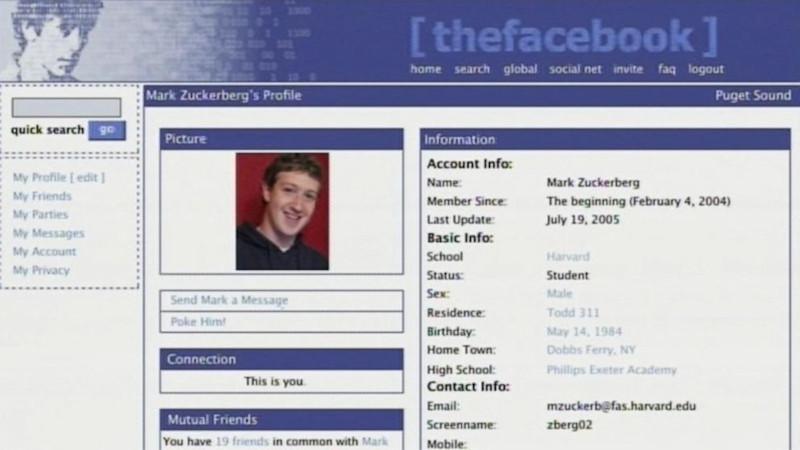
Yet even at their nascent stages, they all sought out small groups of beta testers to gain opinions, validate their original ideas, and test assumptions.
Yes, easier said than done - but bear with us.
Most product managers know well and good that this process involving persistence and iteration can be daunting and sometimes ineffective.
How would YOU go about refining an MVP?
This is a roadmap to help you implement customer development into each phase of your process. We’ll walk you through the process of finding early adopters to use their opinion to enhance your product and to break through the threshold and capture the early majority.
Laying out the framework for you will aid you in the process of refinement through feedback from the target audience and understand how to prioritize opportunities and ideas, which results in a truly great product worthy of adoption. Bonus: Here is an in depth guide on how to create a product adoption strategy.
Why customer development matters

You might be completely convinced that your product is the next big thing but, this question should be keeping you up at night — how can you be sure potential clients will feel the same?
Without validating your assumptions about the user, your product is likely to fail. In fact, according to CB Insights, 42% of start-ups fail due to “No Market Need”, Lack of focus, and failure to consider the buyer persona are the main causes of death.
Have you properly tested your hypothesis about whether people have the problem(s) you think they have?
Serial entrepreneur Steve Blank developed a strategy that scientifically validated the customer need, whether the product addresses that need, whether a company can be built around that product, and — finally — whether that company can support the growth and development of the product.
Customer development is a fairly expansive topic, but these are the building blocks:
Customer discovery. This is the most important stage of the process and involves looking at potential clients and identifying needs they may have. If you already have a product idea in mind, you can carry out this step retrospectively by asking the same question of your concept: does it solve a customer need? Customer discovery can also develop product ideas from scratch, so it’s a pretty multifaceted tool.
Customer validation. The next stage of customer development is to validate that the product you’ve conceived directly addresses the customer's need and successfully solves it.
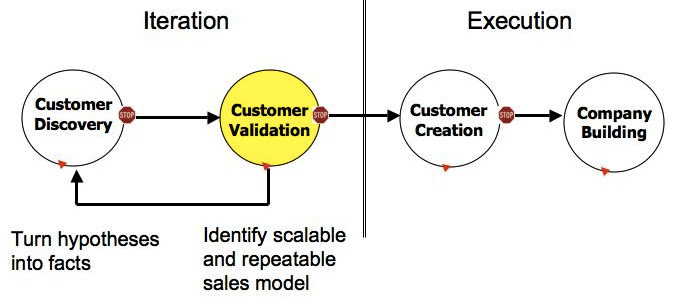
(Source: Steve Blank)
The idea is to start testing these assumptions as early as possible before moving onto the execution phases.
At every stage, the customer development process challenges product developers to ask direct questions not only of the product itself but also of the target audience and prospective clients.
Clearly defined phases will be the blueprint to effectively develop an MVP through customer development.
The next sections will take you through the journey of building your MVP, finding your audiences, validating your assumptions, and prioritizing features to develop a great product that will gain traction.
Building a winning MVP
There are a million possible causes of product failure.
An astounding 42% of products listed lack of understanding of user needs as the main cause.
Perhaps it’s too broad of a solution (13%), or perhaps the opposite is true. The product could even be over-developed and offer too many features(17%) over and above the central problem it solves. This type of over-development often leads to delayed launches, by which time competitors have entered the market and, well, the writing’s often on the wall (1%).
The solution to most of these problems is as effective as it is elegant: the MVP or Minimum Viable Product. If you’ve followed the customer development process to the letter, deploying an MVP should be job #1 as you head towards launch.
What is an MVP?
“The minimum viable product (MVP) is that version of a new product which allows a team to collect the maximum amount of validated learning about customers with the least effort.” - Eric Ries, author of The Lean Startup.
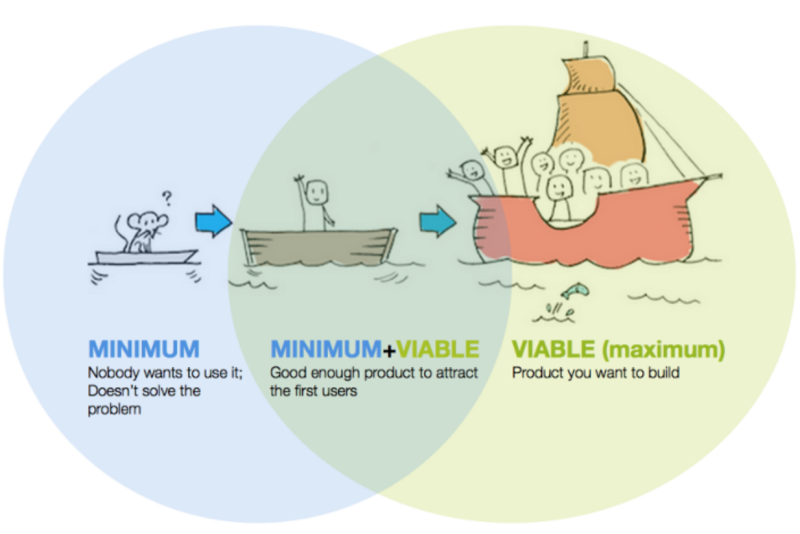
In a nutshell, an MVP is the purest, most stripped-back form of your product idea. As the name suggests, your MVP’s feature set will be minimal, offering users only the functionality they need to solve their problems.
Entirely a “no-frills” offering, MVPs are often a little rough around the edges, especially regarding areas that don’t directly impact functionality — user interfaces and aesthetics are a great example of this.
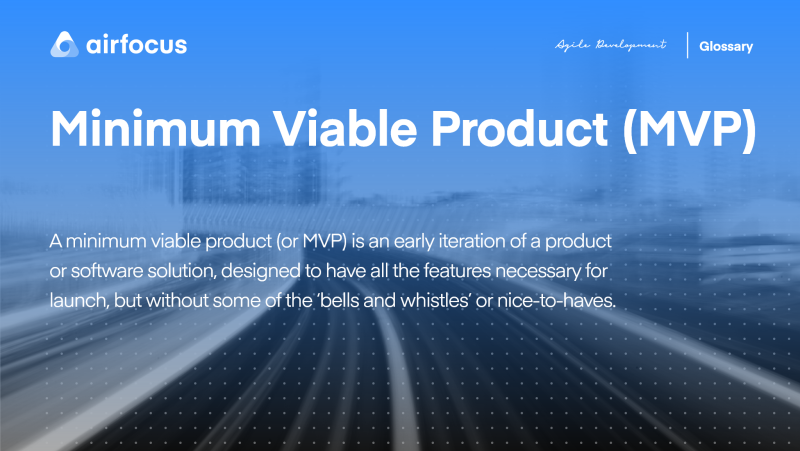
Why deploy an MVP?
With the definitions out of the way, let’s now focus on what’s perhaps the more important part: why you’d want to deploy an MVP.
Of course, there are many reasons, some of which can be very specific to the company, but there are also a few universal truths about MVPs.
Here are the core reasons you should consider launching your product as an MVP:
An MVP validates your core concept. It doesn’t matter how many bells and whistles you add to a product; if its central concept is flawed, it will never work. Deploying an MVP gives you the freedom to truly test your core concept directly — before throwing even more resources (and money) at the product.
MVPs save time and money. One of the most fundamental concepts underpinning an MVP is giving as little time and resources to it as possible to make it functional. After all, there’s no use spending all that time and money on a faulty idea. An MVP can save you from the cost of launching a bad product and gives you an early opportunity to pivot if the worst happens.
MVPs generate user interest early on. We’ll talk much more about this in a later section, but MVPs are often a good way of encouraging early interest from potential clients. By engaging with your prospects and essentially bringing them into the product development process, you’ll find they’re much more likely to become loyal clients and advocates further down the road.
Interlude: Launching an MVP - The airfocus story
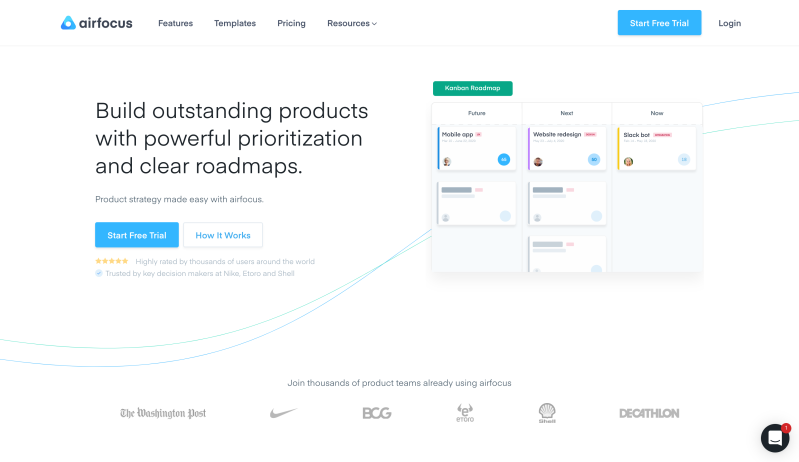
Let’s face it, prioritization is the most important thing for a company, yet hard to achieve and often a hit-and-miss due to logical fallacy, among numerous reasons.
airfocus’ MVP materialized from this utter frustration with fragmented decision-making processes in companies and the lack of prioritization tools in the market.
The truth is that you cannot quantify every single opinion, and oftentimes this is a confounding factor.
People of different backgrounds have different opinions, and while weighing them all equally is great for company culture, it can be counterproductive for the decision-making process.
At airfocus we want to help teams identify and visualize their priorities and give everyone a clear overview of what is important and what is not - Malte Scholz
The world of MVP’s ain’t all sunshine and rainbows - challenging our status quo with feedback
The main and first pain point laid the foundations for airfocus.
Product managers needed to prioritize, and there wasn’t a tool to do it. It was all spreadsheets and/or gut decisions (and let's admit it, Spreadsheets suck and are not built for product management).
airfocus created it - it was flexible, easy to use and to adapt, and was immediately embraced by the product community...but it just wasn’t enough.
The MVP included a prioritization table, framework, and chart view to visualize it all.
The issue with this is that for teams, this goes further than prioritizing.
Teams need to turn priorities into actionable plans, and a roadmap results from a prioritization framework.
This meant that the airfocus team started working diligently on a roadmap feature that would enable clients to instantly create and visualize where they were headed and to get all the stakeholders involved on board.
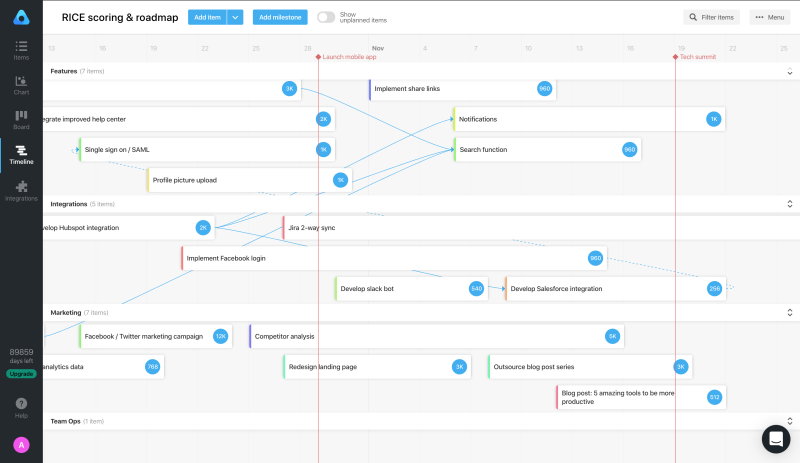
Fast-forward to the present, airfocus is now a comprehensive product operating system, and the first and only modular product management platform, enabling product managers to build the right (successful) products in their own way.

It allows you to collaborate with your team and other stakeholders, making sure all available information comes together in one place.
And last but not least, it integrates with all the tools you already use, connecting perfectly with your workflow.
We strive for simplicity and flexibility at its finest.
This glaring gap in the market for a modern product platform quickly propelled airfocus to attract over hundreds of global clients - from small businesses to large corporations including CAT, Axel Springer, Shopify, Good Year, Marks and Spencer and The Washington Post.
How to increase product adoption
The early adopter phase
You’ve deployed your MVP, and it’s ready to go after testing and getting picked up by a few SaaS-obsessed users trying to stay ahead of the curve, but you are still rather unknown.
Time to attract what’s known as early adopters. You’ve probably heard the term before in the context of smartphone launches and high-end gadgets, but in the context of customer development, the term means something a bit different.
Let’s find out what early adopters really mean to you and your business.
What is an early adopter… really?
At their core, products are really all about solving people’s problems.
If you’ve ever had a niggling issue (and who hasn’t?), you’ll know how it feels to want it solved as soon as possible.
It’s this feeling which serves as the basis of your early adopter group.
Put as simply as possible; an early adopter is someone who is:
Problem-aware. They know they have a specific problem to overcome but don’t currently have a way to do it.
Actively seeking a solution. They genuinely want a product or service which will help them solve their problem.
Why do early adopters matter?
Firstly, if you can convince this group, your adoption will have increased by about 13.5%, and they will have a major role in the funding of your early market, in addition to supplying ideas and missing pieces.
Early adopters are the ideal audience for an MVP because they will happily disregard issues like a clunky user interface or lack of quality-of-life features, so long as the product solves their problem.
If it really does solve their problem, they’ll very often become advocates for you and your product. This is a great way to find brand ambassadors early on in product development who will become champions (and therefore valuable assets) of your company and product.
How to find your early adopters
You should now be totally clued-up on exactly what an early adopter is, and you’re probably pretty excited about getting them on board… but how?
Just like finding paying clients for your product, reaching an audience of potential early adopters is something of an art form.

Luckily, there are a few tricks to keep up your sleeve:
Think about how early adopters might seek to solve their problems. We know this group is actively searching to solve a problem, so there are likely certain avenues they’ll be pursuing. One example could be Product Hunt, which is specifically created for this purpose, or on a more general level certain forums or Facebook or Slack groups where folks interested in your niche hang out.
Physically visit places where early adopters may congregate. This could be trade shows or expos — anywhere that gives you a platform to showcase your solution to people who are actively looking for it. It’s all about getting that solution in front of the people looking for it. The rest of it should just happen naturally.
Breaking-through to early majority
You’ve captured your early adopters, the visionaries, and now you have some momentum going. This is when you need to start pushing your product out to a larger audience.
It’s here that you’ll enter the next phase of the product launch lifecycle and discover your early majority. Let’s meet them…
What is the early majority?
The early majority group is actually fairly similar to early adopters in most respects, with the key difference being that they’re a little tougher to crack. Once they’re on board, however, they’ll often be just as passionate about your product as the early adopters.
An early majority group is made up of people who are:
Problem-aware. They understand that they have a certain issue and are receptive to having it solved.
Not actively seeking a solution. Unlike early adopters, people in the early majority phase are not actively seeking to solve the problem they have. They'll likely respond well to a product that does solve it, but it’s not at the top of their to-do list.
Why does early majority matter?
This audience is essentially the bulk of your market, namely close to 34%, and will decide whether your product is of proven value. This is because they have an in-depth understanding of the issues they face and those with the in-market solutions.
How to find your early majority
Your early majority will be naturally risk-averse and will likely not want to spend anything on early access.
This presents you with a bit of a challenge, but it’s not an insurmountable one.
Here are some of the best ways to win over an early majority crowd:
Get the word out. Just like marketing a fully developed product, converting warm leads into qualified ones is often a matter of delivering the right information. If you want to engage potential early majority audiences, it’s a good idea to request guest blog posts on relevant niche websites, try to generate some publicity, and publish content about your product on your website, too.
Go to where they are. Just like passionate early adopters, members of the early majority are also likely to hang out in the same places. This could be networking events, Facebook groups, or subreddits dedicated to your niche. Even if they don’t respond as passionately as early adopters, simply having your product in front of them puts them at the top of the funnel — and from there, they may just decide to join you.
Effectively using feedback and feature requests
With a validated concept and an engaged audience, now is the time to take that rough diamond of an MVP and turn it into something truly special.
Your core product idea will only take you so far — it’s up to you and your team to build additional features and functionality to make it a must-have product for your customers.
And to do that, you’re going to need to do some talking… and some listening.
Let’s look at the value of feature requests and product feedback.
Discovering what your product is missing
To really take your MVP to the next level, you need to know which features your audience actually want. And to do that, you’re going to need to ask them for feature requests.
Now, you might be thinking that you already have a solid grasp of what the product should be and which features it needs, but that’s not always the case.
Here are 3 great reasons it’s always a good idea to ask for feature requests post-MVP:
Help your team see the wood for the trees.
As we mentioned, you and your team have had your noses pressed up against your MVP for months (or even years), and you’re looking at it through a very specific lens. But in external feature requests, the audience delivering them has no stake in the product — that’s the beauty of it! They’re going to deliver no-holds-barred feedback about what your MVP is missing and what you should add. It might not always be a pleasant experience, but it’s an excellent way to see your product with a new and entirely necessary perspective.
Encourage users to want to try new versions.
We’ve already seen just how valuable a truly engaged audience can be, but this can go double when it comes to new features. Incentivizing users to give you feature requests can be a bit of a tall order, but if you’re able to engage them in the right way, they’ll actually want to do it. One way you can encourage this is to give them "early access" to the latest builds with features they themselves requested.
Help you plan out your product roadmap.
You may already have a pretty good idea of what your product roadmap should look like over the coming months and years, but have you run it past anyone else? If it’s an internal-only document, you may well be missing something. Feature requests from existing users can help you both find new feature ideas to add to your roadmap and prioritize existing ones (more on this later).
Asking for feedback (the carrot and stick way)
While feature requests can fuel your product roadmap and keep your product ahead of the game, there’s another area where client input is essential — and that’s feedback.
Of course, feedback can be good or bad, so you’ll need a thick skin. But, in many cases, negative feedback is actually more useful in the long run.

Feedback pieces are like gold nuggets - scarce and high in value. They are hard to mine for and oftentimes result in low response rates — even with engaged early adopters. For this reason, you’ll most likely need to incentivize feedback from your customers. And that’s where the carrot and stick come in.
Here are just a few effective ways you can encourage your users to actually want to give you feedback:
Deploy surveys with a reward, such as a gift card or prize-draw entry.
Make participants feel really special by granting them access to an exclusive ‘user panel’ or giving them special status in product forums. Everyone loves badges!
Communicate changes resulting from their feedback. They’ll get a kick from seeing their suggestions turn into actions, so this is an easy win.
Make feedback mechanisms as simple as possible. Can you do one-click feedback for certain areas of your product? If so, you’ll find the volume of responses will skyrocket.
Prioritizing feature requests (with the right software support)
With all the feedback and ideas pouring in from your actively engaged users, you’re certainly going to want to manage it the correct way.
Seriously: both feature requests and feedback at this early stage are like gold dust and can make all the difference. In some ways, this is like communicating directly with the product itself — so it’s important to listen.
Documenting feature requests and feedback is one thing, but what happens when the list starts to grow? That’s when you’ll need to do a little prioritizing.
Here at airfocus, prioritizing lists of action items and bringing clarity to complex tasks is right up our street, so we’ve got a few suggestions already. You can even use our AI Assist to help you organize the feedback from multiple sources and analyze its sentiment.
A great thing to do at this point is to employ what’s known as a prioritization framework. There are a few of these available, and they’ll help you make real sense of your feedback — and deal with it in the proper order.
Here are two of the most effective prioritization frameworks you could try out:
RICE scoring
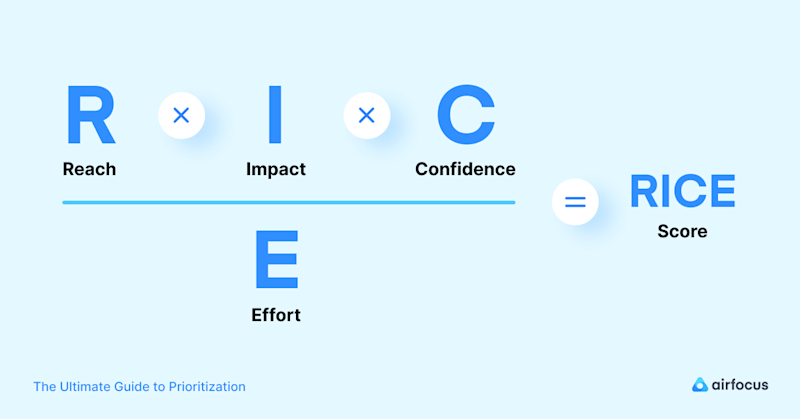
One of the toughest aspects of prioritization is deciding by which metrics you should prioritize. The RICE scoring template aims to solve this by deciding priority based on four metrics:
Reach.
How many users will this feature reach, and over what period of time? The definition of ‘reach’ can be anything from new trial sign-ups to converted clients.
Impact.
This metric refers to how effective (or impactful) a feature will be. For example, how many new sign-ups or inquiries did this feature result in? Impact is rated on a scale of 0.25 (minor impact) to 3.0 (massive impact).
Confidence.
This refers to how sure you are of the previous two metrics. For example, you may have hard data for Reach but only anecdotal evidence for Impact.
Effort.
This final metric essentially summarizes all of those that precede it and helps you weigh up the resources required to implement the feature with the projected benefits from Reach, Impact, and Confidence.
Download now: Get our 5-minute guide on How To Use the RICE Scoring Model
Weighted scoring
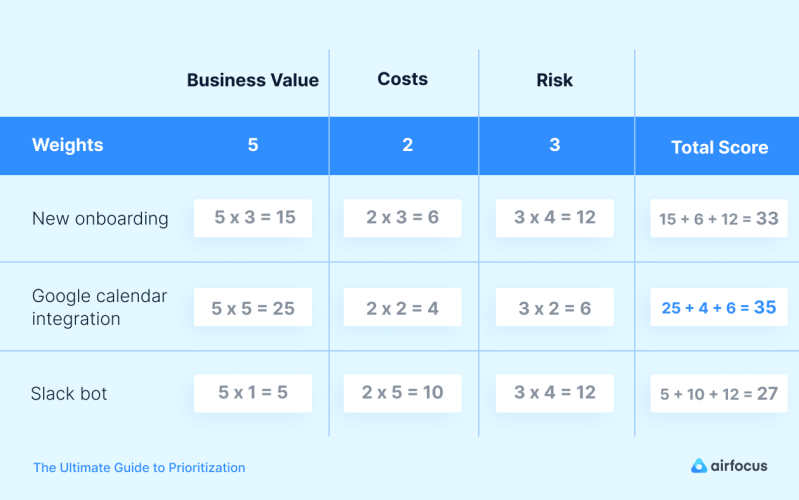
Here’s a prioritization framework that we really love at airfocus. We love it so much, in fact, that we built it right into our product.
But how does it work?
Essentially, the weighted scoring framework challenges you to decide which of the features on your roadmap (or request list) are worth working on first and which aren't.
Weighted scoring requires you to analyze each of the items on your roadmap and assign a score based on a set of criteria you decide upon.
This weighting will be different for everyone and will depend on the goals and objectives of your business and its product. For example, if your goal is to build a customer base, any feature which will result in an uplift of sign-ups will be weighted more heavily.
Once you’ve assigned scores to all of the tasks in your roadmap, you’ll be able to visualize them organized by weight quickly.
This will give you and your team valuable insight into how to tackle feature requests, product updates, and more.
You can read our in-depth weighted scoring guide here.
Conclusion
The iterative process of developing a winning product is a challenge that must be approached in a methodical way in order to be effectively adopted by the target mainstream market.
This process should ultimately:
Empower you and your team to have a better view of how ideas, features, and feedback from different stakeholders can enhance your product while aligning with your company goals.
Pave the way for a constant dialogue that will keep turning your users into brand ambassadors.
Serve as a constant reminder of WHY you are developing your product. There should be a set of hard-fact reasons behind your following steps.
Have a prioritization method that will provide a clear, noise-free overview of ideas that will only generate value without being distracted by high bidders or confounding data points.
Go forth and write your future

We hope you’ve found the story of the MVP something of a page-turner.
If you’re just about to set pen to paper and write the story of your very own product, be sure to check out airfocus and discover just how it can help you change your product management game.
You never know: with strategies like these, your MVP might just end up becoming a worldwide bestseller.
The original article was published in March 2020, last updated in July 2024.

Malte Scholz

Read also





Create effective product strategy

Experience the new way of doing product management



